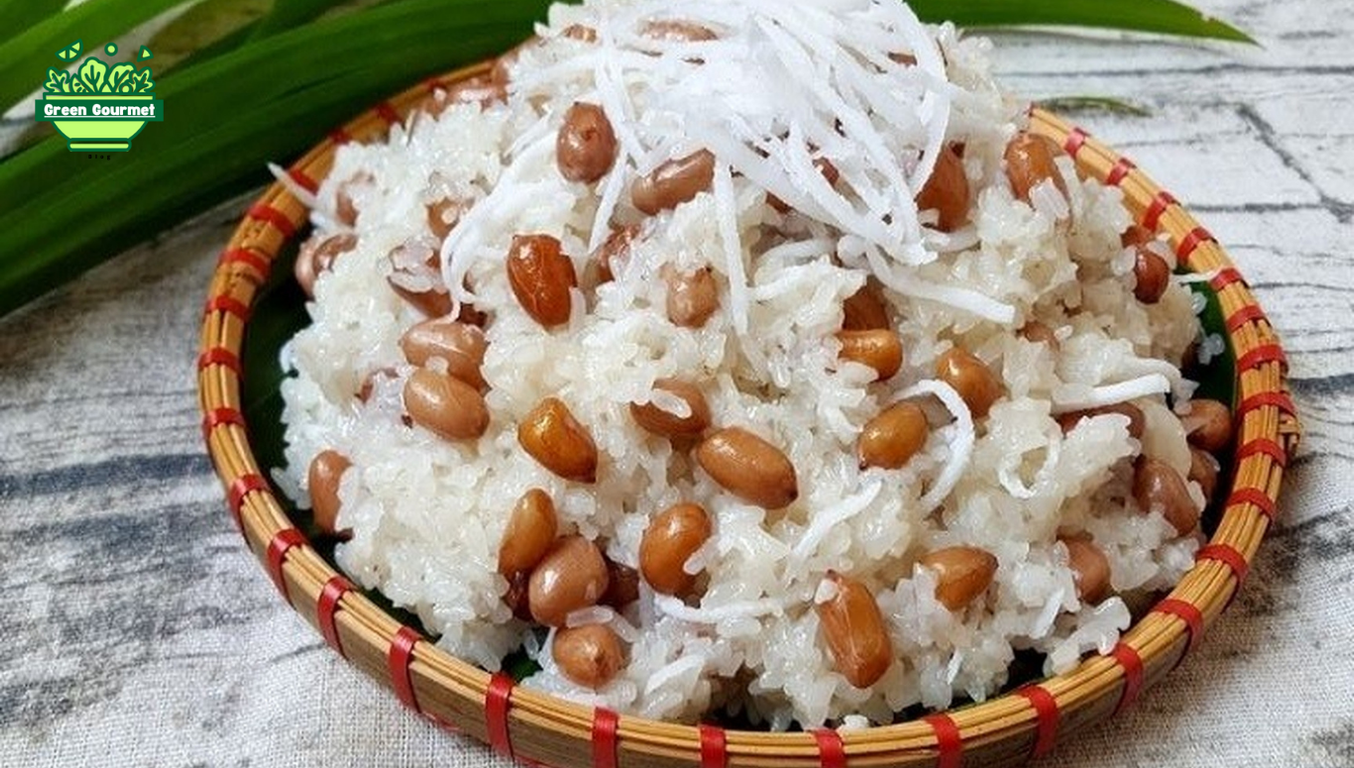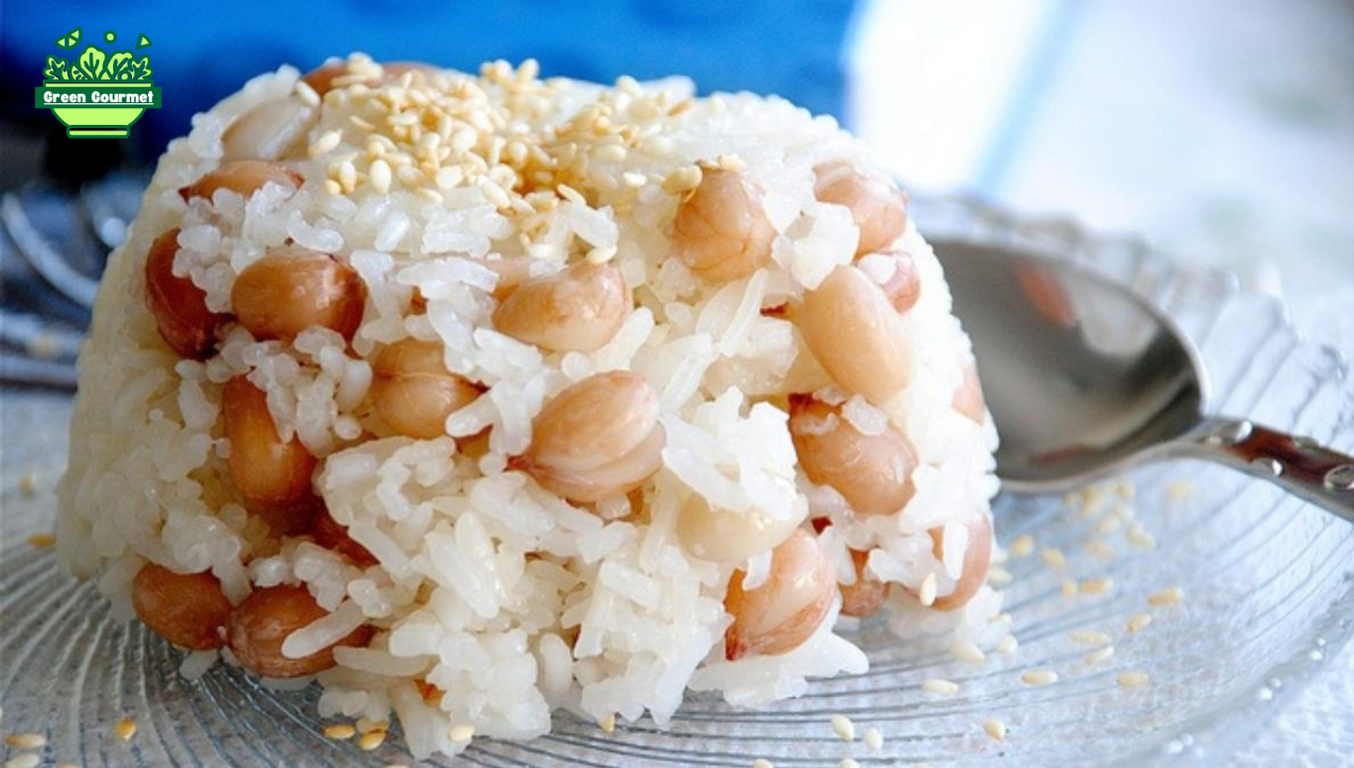Peanut Sticky Rice, or “Xôi Lạc” in Vietnamese, is a simple yet incredibly satisfying dish that combines glutinous rice with roasted peanuts, offering a delightful balance of flavors and textures. This traditional Vietnamese dish is often enjoyed for breakfast or as a snack and is commonly found in street markets and households across Vietnam. The nutty flavor of peanuts pairs perfectly with the soft, slightly chewy texture of the sticky rice, making it a comforting and nutritious meal for any time of the day.
At Green Gourmet, we’ll show you how to make Peanut Sticky Rice, step by step, along with tips for customization, ingredient substitutions, and its cultural significance in Vietnamese cuisine.
How to Make Peanut Sticky Rice
Ingredients:
- 2 cups of sticky rice (soaked for a minimum of 4 hours or overnight)
- 1 cup roasted peanuts (unsalted, lightly crushed)
- 1/2 teaspoon salt
- 1 tablespoon of sugar (optional, to add a hint of sweetness)
- 1 tablespoon vegetable oil or coconut oil
- Fresh shredded coconut (optional, for garnish)
- Sesame seeds (optional, for garnish)
Detailed Steps with Time Breakdown:
- Prepare the glutinous rice (5 minutes prep, 30 minutes cooking):
- Soak the rice: Soak the glutinous rice in water for at least 4 hours or overnight for best results.
- Cook the rice: Drain the soaked rice and steam it for about 30 minutes until soft and fully cooked. Fluff the rice gently with a fork to avoid clumping.
- Prepare the peanuts (5 minutes):
- If using whole peanuts, lightly crush them with a mortar and pestle or the back of a spoon. This helps release their flavor while keeping a satisfying crunch.
- Mix the rice (5 minutes):
- After the sticky rice is done, place it in a large bowl. Stir in the crushed peanuts, salt, and sugar (if using). Drizzle the vegetable oil or coconut oil over the rice to add a bit of richness and shine.
- Serve (immediately or within 10 minutes):
- Garnish the peanut sticky rice with fresh shredded coconut and sesame seeds, if desired. Serve warm as a breakfast dish, snack, or even as a side for a larger meal.
Cultural Significance of Peanut Sticky Rice
Peanut Sticky Rice, or “Xôi Lạc,” is a popular comfort food in Vietnam, often enjoyed in the mornings or as a snack throughout the day. It’s a staple in Vietnamese households, especially during family gatherings, picnics, or even religious festivals. In rural areas, Peanut Sticky Rice is often sold by street vendors in small packages, making it an affordable and filling meal. Its simplicity, combined with the nutritious benefits of peanuts and rice, has made it a favorite across generations.
Ingredient Substitutions for Flexibility
- Peanuts: If you prefer or don’t have peanuts, you can substitute with roasted cashews, almonds, or even sunflower seeds for a different nutty flavor.
- Coconut Oil: Instead of vegetable oil, you can use coconut oil to add a subtle, fragrant richness to the dish.
- Shredded Coconut: Fresh coconut adds extra flavor, but you can also use dried coconut flakes if fresh is not available.
Variations for Different Tastes
- Sweet Peanut Sticky Rice: For a sweeter version, you can increase the sugar and top the sticky rice with a drizzle of coconut cream for added richness.
- Savory Peanut Sticky Rice: For a savory twist, mix in a bit of soy sauce and garnish with fried shallots to create a more complex, umami flavor.
- Peanut and Sesame Sticky Rice: Add toasted sesame seeds into the mix for extra nuttiness, or serve with a sesame-salt mixture (Muối Mè) on the side for dipping.
Nutritional Information of Peanut Sticky Rice
Below is the nutritional information per portion:
| Nutrient | Amount | % Daily Value |
|---|---|---|
| Calories | 320 kcal | 16% |
| Carbohydrates | 55 g | 18% |
| Protein | 8 g | 16% |
| Fat | 9 g | 14% |
| Fiber | 4 g | 16% |
| Calcium | 30 mg | 3% |
| Iron | 1.5 mg | 8% |
Benefits of Peanut Sticky Rice
- Rich in Plant-Based Protein
Peanuts are a great source of plant-based protein, providing essential nutrients and energy. Combined with sticky rice, this dish is not only filling but also nourishing. - Packed with Energy
Sticky rice offers a slow-releasing energy source, making it ideal for breakfast or a pre-exercise meal. - Naturally Gluten-Free
Peanut Sticky Rice is naturally gluten-free, making it suitable for those with gluten sensitivities or allergies. - Simple and Versatile
The simplicity of Peanut Sticky Rice allows for easy customization, making it a versatile dish that can be enjoyed sweet or savory.
Tips for Making Perfect Peanut Sticky Rice
- Soak the Rice: To achieve the perfect sticky texture, ensure you soak the rice for at least 4 hours or overnight.
- Keep it Warm: If you need to keep the rice warm before serving, cover it with a clean cloth to retain moisture and prevent it from drying out.
- Adjust the Sweetness: Feel free to adjust the amount of sugar based on your preference—add more for a sweeter dish or omit entirely for a more savory version.
FAQs About Peanut Sticky Rice
- Q1: How long can peanut sticky rice be stored?
A1: Peanut sticky rice can be stored in an airtight container in the refrigerator for up to 3 days. Reheat it in the microwave or steamer before serving. - Q2: Can I freeze peanut sticky rice?
A2: Yes, peanut sticky rice can be frozen. Simply portion it into airtight containers and freeze for up to 1 month. Thaw and reheat before serving. - Q3: Can I make this dish without peanuts?
A3: Yes, you can use other nuts or seeds like cashews, almonds, or sunflower seeds as a substitute for peanuts. - Q4: What can I serve with peanut sticky rice?
A4: Peanut sticky rice pairs well with savory dishes such as grilled vegetables, steamed greens, or a side of fresh fruits for a complete meal.
Conclusion
Peanut Sticky Rice is a comforting and nourishing dish that perfectly combines the rich, nutty flavors of peanuts with the soft, chewy texture of glutinous rice. Whether enjoyed as a breakfast option, snack, or even a side dish, this simple yet flavorful meal brings the essence of Vietnamese comfort food to your table. With its versatility and easy preparation, Peanut Sticky Rice is sure to become a staple in your kitchen.
How to Make Vietnamese Vegetarian Curry: A Flavorful and Nutritious Plant-Based Dish

